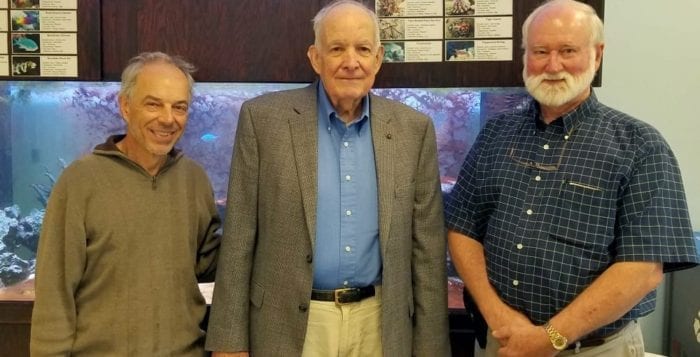Exploring ocean acidification and more with SBU’s Larry Swanson

By Daniel Dunaief
Larry Swanson has led research teams over far-flung water bodies, worked for the National Oceanic and Atmospheric Administration as a commissioned officer for 27 years and has been a fixture at Stony Brook University for over three decades.
A former dean at the School of Marine and Atmospheric Sciences at SBU and current professor, Swanson, who is a member of New York’s Ocean Acidification Task force, was recently interviewed by Times Beacon Record News Media about his life in science.
TBR: How has science changed over the years?
Swanson: Some of the most significant things are the electronic tools that we have today. If you go back to when I was starting, if you wanted a water sample, and to collect temperature at five miles deep in the ocean, it was a very, very long tedious process.
When you got that water sample on deck, if you wanted to simply measure salinity, you had to do a chemical titration. If you were doing that over five miles deep, below the first 1,000 meters, you might take a sample every half a mile or something like that. You couldn’t take a lot of samples.
Now, you lower an instrument and you get a continuous trace of temperature, salinity, dissolved oxygen and other parameters, every few tenths of a meter. We are sort of overwhelmed with data now.
TBR: That must change the way people conduct experiments.
Swanson: When I first started, every data point you collected was extremely valuable and if you lost it, you really lost a lot of time, a lot of energy. It was something you could never recover. With modern instrumentation, you can do so much more and do much of it remotely; you don’t have to go to sea for seven or nine months to do that.
TBR: What are some of the biggest discoveries in your field?
Swanson: This is not necessarily things I have done. The theory of plate tectonics was established. We drilled through the crust of the earth to the mantle and we have discovered hydrothermal vents. We’ve got enough data now that we’re collecting through satellites, direct measurement in oceans in more detail, that we can really talk about changes in the global environment, whether it’s temperature increase, carbon dioxide increase and so forth.
Those are all things that have taken place over my lifetime in oceanography. We can see what we’re doing to ourselves much more clearly today because of new technology.
TBR: What is one of the great debates in science today?
Swanson: I think trying to understand the impacts of climate change is at the forefront for everyone that’s dealing with ocean and atmospheric sciences. We don’t know all the answers and we haven’t convinced everyone it’s an issue.
Whether or not it’s driven by people, that [debate] will continue for years to come. We’re going to bear some of the consequences of climate change before we’ve adequately convinced people that we’ve got to change our lifestyle.
TBR: What about local challenges?
Swanson: The notion of ocean acidification and how rapidly it’s changing is a local challenge. What will the consequences of it be if we don’t try to ameliorate it and what do we need to do in order to make it less of a problem? How are we going to build resiliency and reverse it?
TBR: Is there a scientific message you wish people knew?
Swanson: Scientists in general do not communicate well with the public and part of the problem is because we speak in jargon. We don’t talk to [the public] in proper ways that meet their level of understanding or knowledge. We’ve done that poorly.
For another thing, scientists can be faulted with regard to developing policy. The scientists’ work is never done. If you go to Congress and they ask, “What are we going to do to fix the problem?,” scientists will say, “Give me more money for research and I’ll get back to you.”
So, there’s a disconnect in terms of time frames over which we operate. [Members of Congress] operate 2 to 4 years out, while scientists operate sometimes over lifetimes. We haven’t been able to bridge that gap.
TBR: Is that improving at all?
Swanson: One of the great things that Stony Brook now has is the Alan Alda Center for Communicating Science, which is helping all the scientists here that are willing to participate in trying to do a better job of communicating. It’s making a difference and having an impact that is meaningful. It’s always good to try to put your science in the most simplistic terms possible, even if it’s a drawing or cartoon that’s helpful.
TBR: What are your future goals?
Swanson: I am hopeful the new task force can come up with a meaningful ocean acidification action plan. I’m very pleased to be part of that group.
TBR: If you were to start your oceanography career today, what would you do differently?
Swanson: If I were to start over, I would get a master’s degree in oceanography, not a doctorate, and then I would try to get an environmental law degree. The reason I would probably do that is that I think environmental law is the best way to make an immediate impact on society. I firmly believe that one should not be an environmental lawyer until one is a fairly good scientist.
TBR: How many more years before you retire?
Swanson: I’d say a maximum of three and a minimum of one. I’m often asked, “Why are you still working?” First of all, I enjoy it and I think one of the exciting things about being an oceanographer is that there’s never been a dull day.






